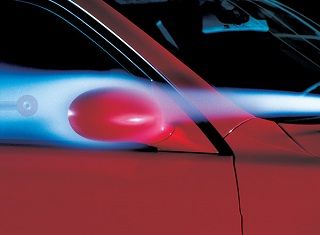From Guest Blogger WiseEnergy: Save With Hypermiling – How Does it Work?
Have you ever honked at that guy who seems to just inch idly towards a red light, or who takes their time to accelerate once the light turns green? What about that jerk who seems to drive on the side of the road, never breaking the speed limit, despite cars whizzing by all around them? If so, then you might have just given your stamp of disapproval to what is known as a hypermiler — someone who is simply trying to do their part for the earth, stretch their gas usage, and save A TON of money in the process.
According to Mother Jones News, hypermiling can help you achieve 40 percent more miles per gallon than you would normally, allowing devout hypermilers to produce even less of a carbon footprint than many hybrid drivers.
How Low Can You Go?
Wayne Gerdes is held as the messiah, of sorts, to the hypermiling community. Having coined the term, he steers the helm of hypermiling community news, tips and training. Gerdes currently holds the record, having driven 1,445 miles on a single tank of fuel in a 2010 Ford Fusion Hybrid. At 81 mpg, he more than doubled the 39 mpg EPA rating. While he may be an extreme case, if everyone made a painless effort to adopt some of his techniques, the environment would applaud and our reliance on foreign oil would be lessened significantly. “Hypermiling not only makes you a more aware driver, but it also produces fuel savings that few other methods or practices ever will,” remarks Gerdes in Mother Jones article.
Nationwide hypermiling practices could not only reduce gas costs and reliance, but it would also create less toxic soil and air. According the the EPA, there are over 1,066 toxic chemical sites in the U.S., and over 11 million people are exposed to them. Companies like Sevenson Environmental carry the burden of cleaning up the worst of them through remediation, but lessening everyone’s toxic burden should be something we all strive to do.
Maintenance & Minimizing Mass
Every little bit helps. Scheduling regular maintenance for your car is of the utmost importance when it comes to saving gas. Low tire pressure can increase the resistance of your car by 1.4 percent for every 1 psi drop in all four tires. Using low weight motor oil and monitoring engine function is also an essential part of keeping your car primed. Jettisoning any excess weight also helps, from your camping chairs to your equipment racks, the lighter you make your car, the more it will thank you.
Stop and Go
Perhaps the practice with the most impact: learn to stop and go with ease. Because speed increases wind resistance, taking off like a bat out of hell causes your engine to work excessively harder, burning gas needlessly. The same goes for braking. Braking should be done with extreme ease. Every time you brake you’re wasting some of the gas you used to to accelerate. Improper braking alone can reduce your gas mileage by up to 33 percent. Yikes!
Don’t Be an Airhead
Reducing air conditioning usage can increase fuel efficiency by up to 25 percent, as the air burns gas like a brush fire in a match factory. Gerdes recommends cracking the driver’s window in front and the rear passenger’s window on the opposite side, which causes less drag. For high speeds he recommends closing the windows and using the fan/ventilation system.
Hypermilers definitely have something going for them — the savings are monumental and it’s probably one of the easiest things you can do to make a substantial environmental impact, advancing yourself into the realm of “true” environmentalist and retiring your armchair status.


Driving at a speed greatly different from the prevailing speed increases the risk of an accident. On multi-lane roads, when traffic is light, it should not be a problem. But when traffic is heavy, or if there is only one lane in each direction, driving at a speed, either too high or too low, disrupts traffic and increases the risk of an accident.
The optimum rate of acceleration to maximize fuel efficiency depends on the car.
For a hybrid car, very gradual acceleration until the engine kicks in maximizes fuel efficiency because batteries lose efficiency when heavily loaded. Once the engine kicks in, somewhat more rapid acceleration probably won’t exact a penalty.
Years ago, BMW did tests to determine the most efficient way to drive their cars. They found that the most economical way was to accelerate with a HEAVY foot, i.e., 2/3 to 3/4 throttle, but to upshift at only 2000 rpm. At more than 3/4 throttle, the carburetor delivered a richer fuel mixture reducing fuel efficiency. Now that cars have fuel injection, it may be that using more than 3/4 throttle would exact a smaller penalty.
A car is most efficient in the highest gear. When accelerating too gradually, one has to spend more time in the lower gears before being able to shift into the highest gear. Thus, a driver who is excessively light-footed will actually get poorer fuel mileage.
The rules are a bit different with a slush pump (automatic transmission). With a slush pump, opening the throttle farther delays upshifts, so probably it is best to accelerate with a moderate throttle, perhaps 1/2 throttle, until reaching the speed at which it will shift into the highest gear with the torque converter locked, then accelerate more gradually. But there again, accelerating excessively gradually is not the most efficient technique.